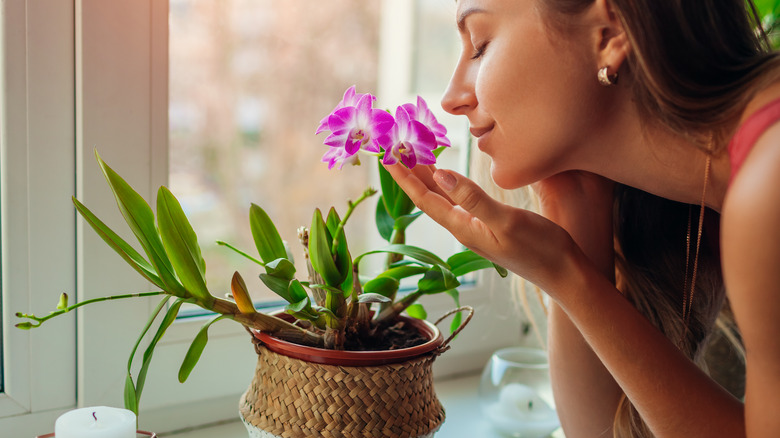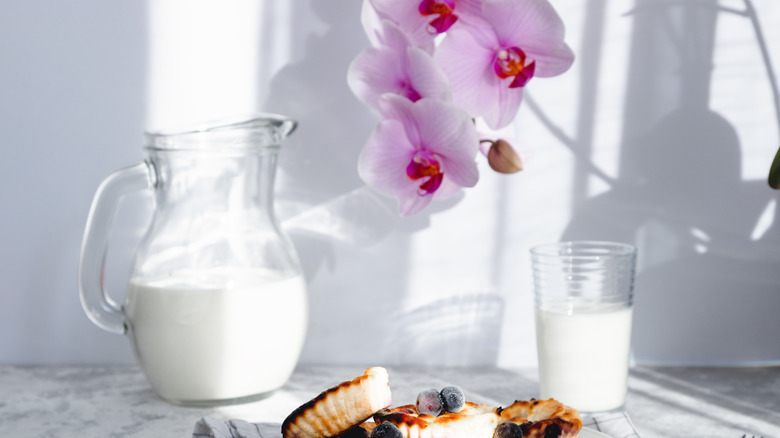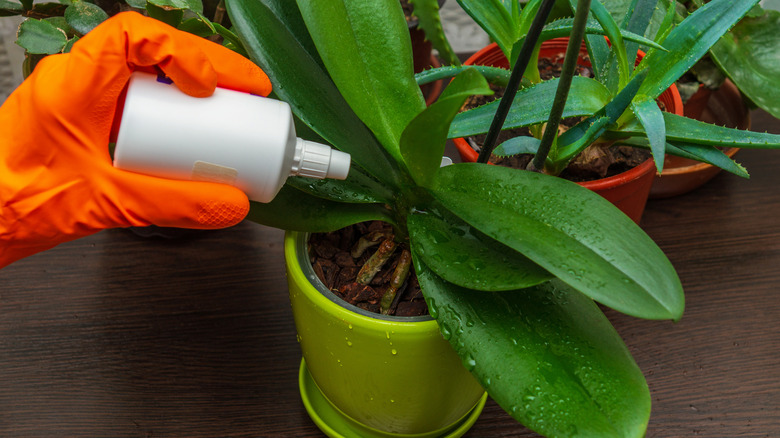How An Empty Milk Carton Can Help Your Orchid Bloom
When it comes to fertilizing your flowers, orchids are a relatively low-maintenance plant. They don't need much fertilizer — in fact, too much can harm them. However, if you understand how to fertilize orchids safely, you can give them important nutrients they need to keep growing and blooming year after year. One surprisingly effective approach is using milk as a fertilizer.
This may sound unorthodox, but milk contains several of the key nutrients found in most fertilizers. That's why watering plants with milk is becoming more popular among houseplant owners, and it works for orchids too. Because orchids require very dilute fertilizer, an easy way to care for them is to take an empty milk container and use the resulting milk-water mix as fertilizer.
In the wild, many orchid species grow on trees, where their tangled roots trap particulate matter floating through the air and absorb nutrients from it. When we keep them indoors, their potting material breaks down over time and becomes depleted of nutrients. Fertilizing will help supplement these nutrients so the plant continues to grow and bloom. Because orchids are so sensitive, however, fertilizing improperly can cause more harm than good. Here are some tips for using milk safely to care for your orchids.
Why you should use milk on your plants
Just as humans need various vitamins and minerals to stay healthy, plants need a combination of nutrients to grow. Fertilizer helps make the soil more fertile by supplementing some of these nutrients. Experts group these nutrients into three categories by decreasing importance: major, minor, and micro. The major nutrients are nitrogen, phosphorus, and potassium, which make up the bulk of most fertilizer products. Minor and micronutrients like calcium, sulfur, iron, and chloride are often included in fertilizers but in smaller quantities.
Once you understand this, it's no surprise that milk works as a fertilizer. Milk contains nitrogen, phosphorus, potassium, and calcium — providing all the major nutrients plants need and some minor ones to create a balanced nutritional supplement.
Milk also makes a convenient fertilizer because most people keep it on hand. Instead of making a trip to the hardware store for fertilizer, you can use a little of what you already have in the fridge. And because spoiled milk is safe for plants, diluting it to turn it into fertilizer is a great way to use milk that's past its expiration date. However, there are some other things to keep in mind when using this homemade fertilizer on your orchids.
How to fertilize orchids safely
The general rule of thumb for orchids is to fertilize "weakly, weekly." Orchids don't like too much fertilizer, so it's best to give them a dilute fertilizer mix more often (every time you water, which is typically every week or so). It's also important to moisten the soil before applying fertilizer because fertilizing a dry orchid can burn the plant's roots.
These guidelines apply whether you're using a storebought fertilizer or a homemade fertilizer like milk. Milk may seem harmless, but it contains many chemicals that must be applied in moderation. Don't fertilize with pure milk; instead, dilute it with water. At least three parts water to one part milk is a safe bet. An easy way to turn milk into a dilute fertilizer is to take a freshly empty milk container, fill it halfway with water, and swish it around. Now you have a half-gallon of low-strength fertilizer you can apply to your orchids over the next few weeks.
You can also put this mixture into a spray bottle, which is an easy way to ensure you don't over-fertilize your orchids. Spray it onto both soil and foliage. Keep an eye on the leaves, and wipe away any fertilizer that doesn't get absorbed to prevent standing water and mold. If you follow these simple tips, milk can help your orchids thrive.


